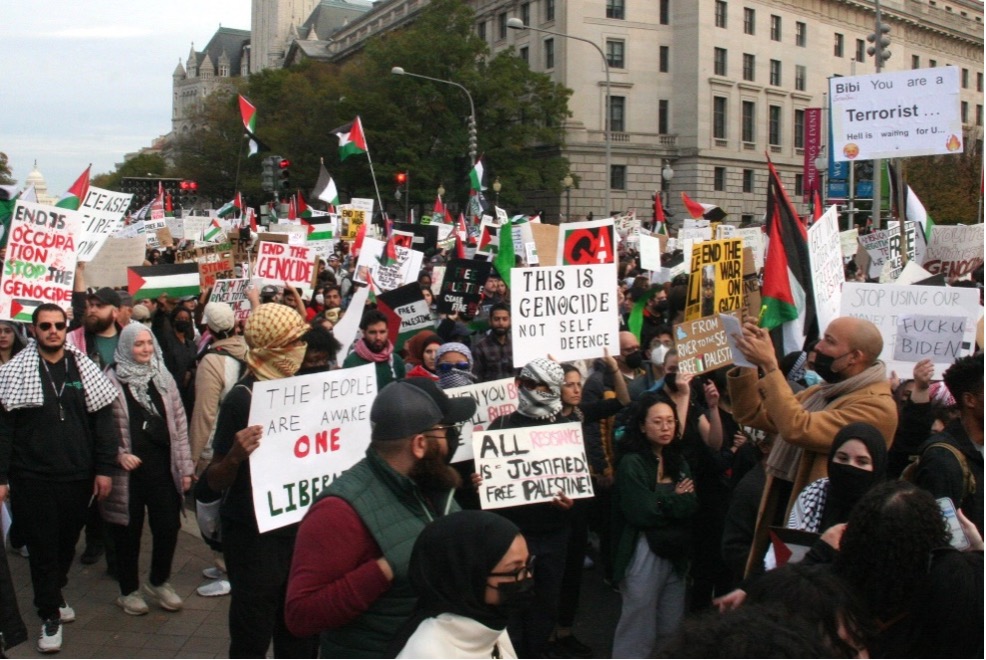Anti-Semitism fueled by radical Islam and leftist ideology
By Yosuke Yamazaki, a U.S.-based journalist
From the Spring Issue of the electronic “Salaam Quarterly Bulletin”, No.48, Feb 2024
Since the attack on Israel by the Islamic organization Hamas last October 7, there has been a sharp increase in incidents of violence and threats based on anti-Semitism on university campuses in the U.S., Europe, and elsewhere. Experts point to a link between radical Islamism and leftist ideology as the reason for this.
Spike in Accusations against Israel and Anti-Semitic Incidents

Immediately after the attack by Hamas, there was a wave of assertions at U.S. universities unilaterally blaming Israel, which was supposed to be the “victim” of the attack. A letter signed by more than 30 student groups at Harvard University was published, stating that “only the apartheid regime is to blame” and denouncing Israel as “responsible for all the violence.”
Also at Cornell University, a history professor was later forced to apologize after describing the Hamas massacre as an “exhilarating and energizing” event at a rally in New York City on the 15th of that month.
Against this backdrop, incidents that appear to be based on anti-Semitism have skyrocketed. According to the Anti-Defamation League, a Jewish human rights group, in the three months since Hamas attacked Israel last October 7, there have been 3,283 anti-Semitic incidents in the US, a 360% increase over the same period last year. This includes physical assaults (60 cases), vandalism (553 cases), and verbal and written harassment (1353 cases).
DEI program fosters anti-Semitism
One program that has been identified as promoting anti-Semitism is the “Diversity Equity and Inclusion” (DEI) program that has spread to colleges and universities across the United States. This program is supposed to create an environment that eliminates discrimination, but in reality, conservatives strongly oppose it because of its discriminatory treatment of white students and its imposition of radical leftist ideology.
The DEI is based on the firm belief that “the world is divided into oppressors and oppressed. Jews are classified as oppressors and Israel is branded as a genocidal colonialist state.” Tabia Lee, the DEI director at De Anza College in California, charged in an op-ed in the New York Post last October 18. Lee, who complained that she was fired when she challenged the college’s policies, criticized the “harmful DEI ideology, which deliberately stirs up hatred against Israel and the Jewish people.”
Anti-Semitism
Where did this ideology, which decries Jews as “oppressors,” come from? In this regard, Charles Asher Small, director of the World Anti-Semitism Policy Institute, interviewed by the author last November, mentioned the name of the late Edward Said, a philosopher who inherited the ideas of the Frankfurt School (one of the sources of neo-Marxism).

Edward Wadie Said (Edward Wadie Said, November 1, 1935 – September 25, 2003) was a Palestinian-American literary scholar and literary critic. Frankfurt School (Edward Wadie Said pictured left in 2002, from Wikipedia)
Said argued that the ideology of Zionism (the Jewish homeland-building movement) is “an extension of Western imperialism that has erased the voice and history of the Palestinian Arab people.” He expressed the view that Jews, victims of the Holocaust, have become “perpetrators” against Palestinians.
Said called himself “the last Jewish intellectual,” despite his Palestinian background. On the other hand, he accused the Jewish intellectuals of the time of “dehumanizing and demonizing the Palestinian people” and helping the Jewish state destroy the lives of Palestinians by supporting Israel.
Oil Money Fueled Said’s Anti-Semitism
According to Small, people at the time considered these ideas of Said’s somewhat insane, but over time they gradually gained influence. And the view that the founding of the state of Israel itself was a colonialist endeavor and that the Jewish people were “colonialists who oppress the Palestinians” is now gaining ground in U.S. universities and elsewhere.
Small said this was fueled by the massive financial support for U.S. universities from Middle Eastern countries such as Qatar, which has an abundance of oil money. A study by the Global Anti-Semitism Policy Institute found that in the 20 years since 2001, about $5 billion has flowed into U.S. universities from Qatar. The Qatari influence has helped spread anti-Semitic discourse in universities by providing professorships, establishing research institutes, and controlling the publishing sector.
Muslim Brotherhood blends European anti-Semitism with Nazism and perverted Islamic doctrine

Dr. Charles Asher Small:Dr. Charles Asher Small was born in Montreal, Quebec, Canada, received his Ph.D.from Oxford University, and taught at the University of London, Ben-Gurion University, Tel Aviv University, and Hebrew University. He holds a Doctor of Philosophy (D.Phil.) from St. Antony’s College, Oxford University. He is the founder and director of the Institute for Global Anti-Semitism and Policy Studies. He is also a Research Fellow at St. Antony’s College, Oxford University, and a Senior Fellow at the Moshe Dayan Center for Middle Eastern and African Studies and the Hartog School of Government and Policy at Tel Aviv University. In August 2010, in New Haven, Small was elected to the President of the newly formed International Association for the Study of Antisemitism (IASA). (From Wikipedia)
The organization in close relationship with Qatar is the Muslim Brotherhood, an Islamic organization founded in Egypt about 100 years ago. Small pointed out that it is “the intellectual and spiritual leader of the Qatari royal family, and Qatar is essentially the Muslim Brotherhood.” He added that the Muslim Brotherhood “has taken European anti-Semitism and Nazism and merged it with perverted Islamic doctrine. “They call for the murder and destruction of Jews around the world and seek to destroy democratic societies and replace them with a caliphate [successor to the Prophet Muhammed],” he accused.
Hamas, which has carried out brutal attacks against Israel, also has the Muslim Brotherhood as its parent organization. The theoretical founders of the Muslim Brotherhood are also respected by Iranian leaders.
At U.S. universities, which have received significant funding from Qatar, the discourse that Jews are “white supremacists,” “colonialists,” and “Nazis” has spread. Small calls this an “alliance of red (symbolizing communism) and green (symbolizing Islam)” by Islamic extremists and far-left forces.
Small said, “Islamic extremists are opposed to the ‘hegemony’ of the United States and other Western countries and want to remove the influence of these countries from the Middle East region. Marxists agree with them. They are united in their goal of undermining democracies,” he warned.
Archives
1. Oct. 2023 Massive “Hamas” Terrorism Not Good for Palestine
1. Aug. 2023 Approval of the UK’s TPP Membership and Six Eyes
1. May. 2023 Saudi-led Arab countries
1. Feb. 2023 Japan Earns Trust as a Peaceful Nation
1. Nov. 2022 Gulf States and Israel Looking for Peace
1. Aug. 2022 Former Prime MinisterShinzo Abe, who made Japan credible as a global peaceful nation.
1. May. 2022 Warfare in the New Era:Digital Strategies as Deterrence Enhancement
11. Feb. 2022 Deepening and Expanding the Japan-US Alliance is the Way to Overcome China’s Communist
11. Nov. 2021 Free and Open Indo-Pacific Initiative and Afghan Problems
11. Aug. 2021 Peace in the Middle East and Japan: On the Occasion of the 30th Anniversary of the Gulf War
11. May. 2021 “Free and Open Indo-Pacific” for which global support is expanding
11. Feb. 2021 Thorium Molten Salt Reactors That Open the Gate of the Second Atomic Energy Age
11. Nov. 2020 Seriousness of Pompeo’s View on China and Subsequent Policy
11. Aug. 2020 Japan to set sail for full-scale peace diplomacy to the Middle East (3)
11. May. 2020 Japan to set sail for full-scale peace diplomacy to the Middle East (2)
11. Mar. 2020 Japan to set sail for full-scale peace diplomacy to the Middle East (1)
11. Nov. 2019 e-sports featured as a cultural project in the National Sports Festival
11. Aug. 2019 Status of Crude Oil Prices
11. May. 2019 Polygamy debate in Egypt: Statement of Ahmed el-Tayeb, Grand Imam of al-Azhar, supreme authority of Sunni
11. Feb. 2019 Year 2018 turned out to be the first year of e-sports
11. Nov. 2018 Trends in world economy and crude oil price in a Goldilocks economy
11. Aug. 2018 Full-scale launch of the plan to make programming education for e.s. compulsory by 2020
11. May 2018 President el-Sisi’s achievements over the past four years and prospects for the next four years
11. Feb. 2018 ESports getting prevalent in the Middle East ― To be an official athletic event from 2022 Asian Games
11. Aug. 2017 Aggressiveness of Islam and Imam’s anti-terrorism declaration
11. May 2017 Countdown to the destruction of the Islamic State of Iraq and Syria (ISIS)
11. Feb. 2017 Trump administration’s policy toward the Middle East
11. Nov. 2016 25 years after the end of Gulf – “Meeting of supreme Islamic leaders”
11. Aug. 2016 Announcement of the construction plan of the bridge between Saudi Arabia and Egypt across the Red Sea
11. May 2016 Deepened international collaboration for destruction of ISIL: Desired outcome of G7 Summit
11. Feb. 2016 Saudi Arabia vs Iran, Crucial moment
11. Aug. 2015 The results of international encirclement against the militant group, the Islamic State and the future challenges
11. May 2015 The GCC DAYS IN JAPAN held in Tokyo April 22-24, 2015
11. Feb. 2015 The limitation of the Arab Spring ― Egypt and Tunisia after the Arab Spring
11. Nov. 2014 3 Months from the Islamic State Shock – Change of US Strategy for Air-Strikes and Encirclement
11. Aug. 2014 High expectation for Egypt’s el-Sisi administration’s efforts in mediating ceasefire
11. May 2014 Kuwait’s enthusiastic assistance for recovery from Great East Japan Earthquakes
11. Feb. 2014 Roadmap to Democratization of Egypt
11. Nov. 2013 Era in which “Live Healthy” is contribution to the society
11. Aug. 2013 Public speech of Ms. Sara Akbar
11. May 2013 Merits and demerits of the US-Iraq War
11. Feb. 2013 Expectation for Prime Minister Abe to implement the best energy policy
